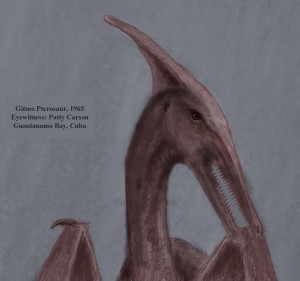By modern pterosaur expert Jonathan Whitcomb
This “Press Room” page is not intended to compete with the Live Pterosaur Media Center. Neither do I intend to duplicate portions of those web pages of that online press room. Neither do I intend to write a blank check for promoting the validity of all claims regarding sightings of flying creatures that eyewitnesses or claimed-eyewitesses report to us. I do intend to set right common misunderstandings concerning the extinction of all pterosaurs, meaning all species of Rhamphorhynchoid and Pterodactyloid. This controversay I now address.
Pterosaur Extinction
I first address comments made by Brian Switek on a blog post for the Smithsonian Magazine, the post being titled, “Don’t Get Strung Along by the Ropen Myth.” I do not question whether or not he is a pterosaur expert in the normal meaning of those words, but he is doggedly dogmatic in defending pterosaur extinction. He said, regarding that:
there is no indication that any of them survived past the close of the Cretaceous. Had they survived, they would have left us some fossil clues. Even coelacanths—fleshy-finned fish said to be “living fossils” when they were discovered in the 20th century for the lack of a fossil record between the Cretaceous and the present day—are now represented by fossils which postdate the end of the Mesozoic. If pterosaurs were still living we would expect to find some kind of fossil evidence that they persisted much longer than previously thought.
I did a Google search with the term, “postdate the end of the Mesozoic.” The only result with that exact wording was that one blog post by Switek. I mention this because his meaning may be vague. I presume he means that we now have coelacanth fossils that are dated after the end of the Mesozoic. Since he is trying to discredit the idea that pterosaurs have lived after the Mesozoic, that is probably what he means.
Switek seems to have entirely failed to comprehend what is entailed here. If the discovery of a modern living Coelacanth could have opened up the way for dating some Coelacanth fossils as being after the Mesozoic, the discovery of a modern living pterosaur could open up the way for dating some pterosaur fossils as also being more recent. This perspective was probably entirely overlooked by Switek.
Perhaps I can put that more simply. Before the discovery of a living Coelacanth, all fossils of that fish were dated at many millions of years old. After that fish type was found to be alive, paleontologists were free to date Coelacanth fossils as having lived more recently. A critical point in this is that this fish was an index fossil, meaning the presence of a fossil of this fish would cause a layer of soil to be dated at 65 million years old at the least. Index fossils are a primary means to date soil, in the standard procedures of paleontology.
Switek hints that Creationists look at things differently, with a different perspective. But he uses the word “Creationist” as a means to discredit those who have advocated the existence of modern living pterosaurs. That controversay of the conflict between standard models of Darwinian macro-evolution and Biblical Creationism is too deep to be covered here. I close by listing a few of the images available for the news media, the links taken from the Whitcomb Live Pterosaur Media Center.
Modern Pterosaur Administration








2 Replies to “Press Room for Modern Pterosaur”
Comments are closed.